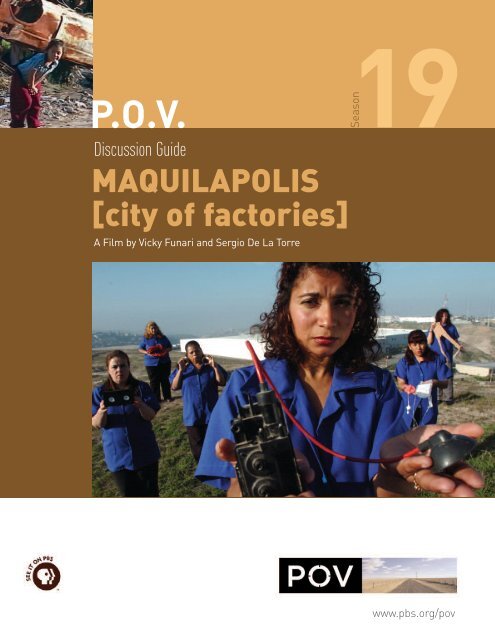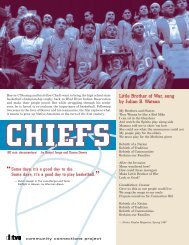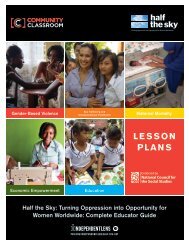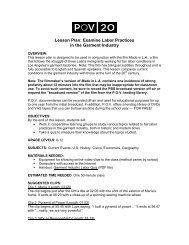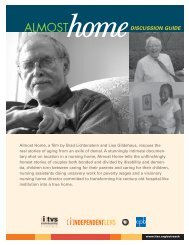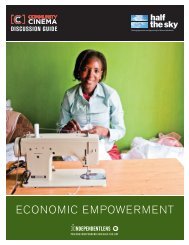Discussion Guide - PBS
Discussion Guide - PBS
Discussion Guide - PBS
- No tags were found...
You also want an ePaper? Increase the reach of your titles
YUMPU automatically turns print PDFs into web optimized ePapers that Google loves.
P.O.V.19<strong>Discussion</strong> <strong>Guide</strong> | MAQUILAPOLIS [city of factories]Table of Contents Credits, AcknowledgementsSeason5 Introduction6 Potential Partners6 Key Issues6 Event Ideas7 Using this <strong>Guide</strong>7 Planning an Event8 Facilitating a <strong>Discussion</strong>8 Finding a Facilitator8 Preparing Yourself9 Preparing the Group10 Background Information10 The maquiladoras and theNorth American Free Trade Agreement11 Today in Tijuana12 An Update on Metales y Derivados13 Selected People Featured inMAQUILAPOLIS [city of factories]14 General <strong>Discussion</strong> Questions15 <strong>Discussion</strong> Prompts17 Taking Action18 Resources20 How to Buy the FilmWriterFaith Rogow, PhDInsighters Educational Consulting<strong>Guide</strong> ProducersEliza LichtSenior Manager, Community Engagement and Education, P.O.V.Shabnam AhamedOutreach and Development Assistant, P.O.V.Irene VillaseñorYouth Views Manager, P.O.V.Jessica LeeIntern, Community Engagement and Education, P.O.V.Content Reviewer: Cari LaddDesign: Rafael JiménezCopy Editor: Kris WiltonThanks to those who reviewed this guide:Vicky FunariFilmmaker, MAQUILAPOLIS [city of factories]Amelia SimpsonEnvironmental Health Coalition© American Documentary, Inc.4
P.O.V.19<strong>Discussion</strong> <strong>Guide</strong> | MAQUILAPOLIS [city of factories]IntroductionSeasonIn MAQUILAPOLIS [city of factories], a powerful sixty minutedocumentary, American and Mexican-American filmmakersjoin together with Tijuana factory employees and communityorganizers to tell a story of globalization through the eyes of theworkers. In exchange for producing the cheap consumer goodsthat people in wealthier nations crave, the workforce ofTijuana’s maquiladoras (factories) have received wages higherthan those available to them elsewhere in Mexico, but the pricefor those wages has been miserable working conditions, healthproblems, pollution and broken promises.A factory.Photo Annelise WunderlichThrough video diaries, two of these women, Carmen Durán andLourdes Luján, chronicle their lives in and around themaquiladoras. The result is not only an informative anddisturbing film, but also an evocative and poetic one. Aspromotoras — advocates who fight for workers’ rights — Duránand Luján serve as role models for taking action in the face ofadversity.© American Documentary, Inc.5
P.O.V.19<strong>Discussion</strong> <strong>Guide</strong> | MAQUILAPOLIS [city of factories]Potential Partners Key IssuesSeasonMAQUILAPOLIS [city of factories] is well suited for use in avariety of settings and is especially recommended for use with:• Your local <strong>PBS</strong> station• Groups that have discussed previous <strong>PBS</strong> and P.O.V.films relating to Mexican/American relations, povertyor environmental issues, including The Sixth Section,Farmingville, or Al Otro Lado.• Groups focused on any of the Key Issues listed to theright• Legislators• High school students• Faith-based organizations and institutions• Academic departments and student groups at colleges,universities, community colleges and high schools• Community organizations with a mission to promoteeducation and learning, such as P.O.V.’s nationalpartners Elderhostel Learning in Retirement Centers,members of the Listen Up! Youth Media Network, oryour local library.Event IdeasUse a screening of MAQUILAPOLIS [city of factories] to:• Celebrate International Women’s Day (March 8),Labor Day (the first Monday in September),Earth Day (April 22) or Hispanic Heritage Month(September 15 – October 15).• Invite your elected officials to discuss their positionson NAFTA. Ask them to explain the provisions of thetreaty and its impact.• Convene a panel of experts to compare the environmentalissues raised in the film with responses toindustrial pollution in your community.• Tell the story behind how a category of consumerproducts, such as clothing or electronics, comes tomarket. Discuss how our purchasing decisions mighthelp or harm workers in developing countries.MAQUILAPOLIS [city of factories] is an excellent tool foroutreach because it lets the people directly involved tell theirown stories, bringing global issues down to a personal andpractical level. The film will be of special interest to peopleinterested in the issues below:• Activism• Border issues• Economics• Environmental justice• Environmental law• Feminism• Globalization• Immigration• Industrialization• International trade• Labor, migrant labor, or unemployment• Mexican/American border• Multinational corporations• North American Free Trade Agreement• Pollution• Poverty• Sexism• Social justice• Unions• Women’s studies© American Documentary, Inc.6
P.O.V.19<strong>Discussion</strong> <strong>Guide</strong> | MAQUILAPOLIS [city of factories]Using this <strong>Guide</strong>SeasonThis guide is designed to help you use MAQUILAPOLIS [city of factories] as the centerpiece of a community event. It containssuggestions for organizing an event as well as ideas for how to help participants think more deeply about the issues in thefilm. The discussion questions are designed for a wide range of audiences. Rather than attempt to address them all, chooseone or two that best meet the needs and interests of your group.Planning an EventIn addition to showcasing documentary film as an art form, screenings of P.O.V. films can be used to present information, get peopleinterested in taking action on an issue, provide opportunities for people from different groups or perspectives to exchange views,and/or create space for reflection. Using the questions below as a planning checklist will help ensure a high-quality, high-impactevent.• Have you defined your goals? Set realistic goals with your partners. Will you host a single event or engage in an ongoingproject? Being clear about your goals will make it easier to structure the event, target publicity and evaluate results.• Does the way you are planning to structure the event fit your goals? Do you need an outside facilitator, translator or signlanguage interpreter? If your goal is to share information, are there local experts on the topic who should be present? Howlarge an audience do you want? (Large groups are appropriate for information exchanges. Small groups allow for moreintensive dialogue.)• Have you arranged to involve all stakeholders? It is especially important that people be allowed to speak for themselves. Ifyour group is planning to take action that affects people other than those present, how will you give voice to those not in theroom?• Is the event being held in a space where all participants will feel equally comfortable? Is it wheelchair accessible? Is it ina part of town that’s easy to reach by various kinds of transportation? If you are bringing together different constituencies, isit neutral territory? Does the physical configuration allow for the kind of discussion you hope to have?• Will the set-up of the room help you meet your goals? Is it comfortable? If you intend to have a discussion, can people seeone another? Are there spaces to use for small breakout groups? Can everyone easily see and hear the film?• Have you scheduled time to plan for action? Planning next steps can help people leave the room feeling energized andoptimistic, even if the discussion has been difficult. Action steps are especially important for people who already have a gooddeal of experience talking about the issues on the table. For those who are new to the issues, just engaging in publicdiscussion serves as an action step.© American Documentary, Inc.7
P.O.V.19<strong>Discussion</strong> <strong>Guide</strong> | MAQUILAPOLIS [city of factories]Using this <strong>Guide</strong>SeasonFacilitating a <strong>Discussion</strong>Who Should Facilitate?Controversial topics often make for excellent discussions. You may or may not be the best person to facilitate,By their nature, those same topics can also give rise to especially if you have multiple responsibilities for yourdeep emotions and strongly held beliefs. Strong facilitatorscan create an atmosphere where people feel safe, be wise to ask someone more neutral to guide theevent. If you are particularly invested in a topic, it mightencouraged and respected, making it more likely that they dialogue.will be willing to share their ideas openly and honestly.If you need to find someone else to facilitate, someHere’s how:university professors, human-resource professionals,clergy and youth leaders may be specially trained inPreparing YourselfIdentify your own hot-button issues. View the filmbefore your event and give yourself time to reflect so youaren’t dealing with raw emotions at the same time thatyou are trying to facilitate a discussion.Be knowledgeable. You don’t need to be an expert onMexico, working conditions, or international trade tofacilitation skills. In addition to these local resources,groups such as the National Conference for Communityand Justice (NCCJ) and the National Association forCommunity Mediation (NAFCM) may be able to provide orhelp you locate skilled facilitators. Be sure that yourfacilitator receives a copy of this guide well in advance ofyour event.lead an event, but knowing the basics can help you keep a discussion on track and gently correct misstatements offact. In addition to the Background Information section above, you may want to take a look at the suggested websitesand books in the Resources section on p. 18.Be clear about your role. You may find yourself taking on several roles for an event, such as host, organizer or evenprojectionist. If you are also planning to serve as facilitator, be sure that you can focus on that responsibility and avoiddistractions during the discussion. As members of the group share their viewpoints, it is important to remain neutraland help the discussion along without imposing your views on the dialogue.Know your group. Issues can play out very differently for different groups of people. Is your group new to the issue orhave they dealt with it before? Factors like geography, age, race, religion and socioeconomic class can all have animpact on comfort levels, speaking styles and prior knowledge. Take care not to assume that all members of aparticular group share the same point of view. If you are bringing together different segments of your community, westrongly recommend that you hire an experienced facilitator.© American Documentary, Inc.8
P.O.V.19<strong>Discussion</strong> <strong>Guide</strong> | MAQUILAPOLIS [city of factories]Using this <strong>Guide</strong>SeasonPreparing the GroupConsider how well group members know one another. If you are bringing together people who have never met, youmay want to devote some time at the beginning of the event for introductions.Agree to ground rules around language. Involve the group in establishing some basic rules to ensure respect and aidclarity. Typically such rules include prohibiting yelling and the use of slurs and asking people to speak in the firstperson (“I think….”) rather than generalizing for others (“Everyone knows that…”).Ensure that everyone has an opportunity to be heard. Be clear about how people will take turns or indicate that theywant to speak. Plan a strategy for preventing one or two people from dominating the discussion. If the group is large,are there plans to break into small groups or partners, or should attendance be limited?Talk about the difference between dialogue and debate. In a debate, participants try to convince others that they areright. In a dialogue, participants try to understand one another and expand their thinking by sharing viewpoints andlistening actively. Remind people that they are engaged in a dialogue. This will be especially important in preventing adiscussion from dissolving into a repetitive, rhetorical, political or religious debate.Encourage active listening. Ask the group to think of the event as being about listening as well as discussing.Participants can be encouraged to listen for things that challenge as well as reinforce their own ideas. You may alsoconsider asking people to practice formal “active listening,” where participants listen without interrupting the speaker,then re-phrase what was said to be sure they have heard correctly.Remind participants that everyone sees through the lens of his or her own experience. Who we are influences howwe interpret what we see. Everyone in the group may have a different view about the content and meaning of the filmthey have just seen, and each of them may be accurate. It can help listeners to understand others’ perspectives ifpeople identify the evidence on which they base their opinions.Take care of yourself and group members. If the intensity level rises, pause to let everyone take a deep breath. Youmight also consider providing a safe space to vent, perhaps with a partner or in a small group of familiar faces. If youanticipate that your topic may upset people, be prepared to refer them to local support agencies or have local professionalspresent. Think carefully about what you ask people to share publicly, and explain things like confidentiality andwhether press will be present.© American Documentary, Inc.9
P.O.V.19<strong>Discussion</strong> <strong>Guide</strong> | MAQUILAPOLIS [city of factories]Background InformationSeasonThe maquiladoras and North American FreeTrade Act (NAFTA)In 1965, the Mexican and United States governmentsestablished the Border Industrialization Program, designed toencourage the building of factories near the U.S. border as away to create work for impoverished Mexicans.The U.S. and Mexican Governments, which hoped that anincrease in work opportunities in Mexico would result in fewerillegal immigrants, provided U.S. companies with taxincentives.Under the program, an American corporation couldset up a plant in Mexico, ship parts or raw materials there forassembly duty-free and bring the finished goods back into theU.S. virtually duty-free. Attracted by the promise of cheaperlabor and unenforced regulations, American companiesestablished maquiladoras, and Americans were provided withcheaper consumer goods.Factory workers Lourdes Luján and Carmen Durán display thecomponents they make in Tijuana's maquiladoras.Photo David MaungIn 1994, the implementation of NAFTA led to a boom in theestablishment of maquiladoras both on the border andelsewhere in Mexico, as all of the country became eligible forthe tariff waivers. The growth of maquiladoras has been ofparticular concern to environmentalists, because the industriesinvolved (e.g., electronics) tend to use significant amounts ofhighly toxic substances (like solvents) in their productionprocesses. As they attracted workers, the factories alsospurred rapid population growth in nearby areas lacking basicinfrastructure for essential services like sanitation. 1© American Documentary, Inc.10
P.O.V.19<strong>Discussion</strong> <strong>Guide</strong> | MAQUILAPOLIS [city of factories]Background InformationSeasonOpponents of NAFTA predicted some of these results andpressed for side agreements intended to curb pollution. TheNorth American Commission for Environmental Cooperationwas created to encourage adherence to those agreements, butit had no authority to force clean-ups. That was left to the NorthAmerican Development Bank (NADBank) and the BorderEnvironment Cooperation Commission (BECC), which are jointlyfunded by the U.S. and Mexico.NAFTA also contained provisions intended to preserve basicworker rights. These are supervised [again, enforced?] by theNorth American Agreement on Labor Cooperation (NAALC) andthe Office of Trade Agreement Implementation (OTAI). However,despite many reports of both environmental and labor abuses,enforcement of NAFTA’s side agreements has been lax to date. 2According to the Carnegie Endowment for International Peace,funding for onsite inspections of manufacturing plants hasdropped 45 percent since NAFTA was signed.NAFTA supporters point out that over the past decade the U.S.Environmental Protection Agency has spent more than half abillion dollars on cleaning contaminated water and improvingair quality in border areas that have grown under the treaty.They also emphasize that Mexico's gross domestic product hasincreased from $767 billion to more than $1 trillion sinceNAFTA’s implementation. 3Today in TijuanaRoad flooded with waste waterPhoto courtesy of “MAQUILAPOLIS [city of factories]”After several years of decline following the dot-com bust,Tijuana’s maquiladoras are on the rebound. Because of itsproximity to the U.S. border, the city has been especiallyattractive to producers of large or heavy items such as refrigeratorsthat are costly to ship from Asia and to retailers whowant quick shipment options that allow them to avoid keepinglarge inventories on hand.According to the Instituto Nacional de Estadìstica Geografia eInformatica [Source: http://www.inegi.gob.mx/est/contenidos/espanol/tematicos/coyuntura/pubcoy/entidades/02/pomaq.asp?c=4087&e=02], 239,114people in the Mexican state Baja California, are currently© American Documentary, Inc.11
P.O.V.19<strong>Discussion</strong> <strong>Guide</strong> | MAQUILAPOLIS [city of factories]Background InformationSeasonemployed in maquiladoras. This number represents about 9%of the total population of the state. The National Council for theExporting Maquila Industry reports that 1.1 million people workin the industry nationwide.For corporations, locating assembly plants in Mexico continuesto offer substantial savings. In Tijuana, a maquiladora workerearns $1.80 an hour and works 48 hours a week. In nearbyCalifornia, the minimum wage is over $7 an hour for a 40-hourwork week. In addition, the maquiladoras pay no state taxes aslong as the company shares 10% of its profits with itsemployees. Rodrigo Vargas of the Tijuana EconomicDevelopment Corporation says that on average, a maquiladorasaves a company $10,000 a year per employee. 4An Update on Metales y DerivadosAt least 2,000 tons of waste has been removed from the site ofthe former battery recycling plant, which is located approximately600 yards from Colonia Chilpancingo, home to morethan 10,000 people. However, as much as 10,000 tons of debrisremains.Mexico estimates the entire cleanup will cost $7 million.Completed in 2004 the first phase was finished through a$700,000 joint effort between the Environmental ProtectionAgency, the Mexican government, and Baja California’s stategovernment. 5 Since then the U.S. government has pledgedClean up of Metales y DerivadosPhoto courtesy of “MAQUILAPOLIS [city of factories]”another $80,000 and the Mexican government, $250,000. Theremaining funds needed to finish cleanup of the site have yet tobe determined.The company's owner, José Kahn, who fled to the U.S. to avoida Mexican arrest warrant for his company’s environmentalviolations, passed away in San Diego a few months after theclean-up began. Neither Kahn nor his New Frontier TradingCompany has contributed to the cost of clean-up. 61 “Say Goodbye to High-Tech Jobs: Many Are Moving Offshore.” By: Donald L.Barlett and James B. Steele, The Philadelphia Inquirer, September 16, 19962 “A Free Trade Boom or an Environmental Bust?” NAFTA Missteps Harm MexicoCritics Say” By: Letta Tayler, Newsday, December 29, 20033 “Behind the Debate: Propelled to Protest, Driven to Migrate; Mexican Deportee’sU.S. Sojourn Illuminates Roots of Current Crisis.” By: Manuel Roig-Franzia, TheWashington Post, April 17, 20064 “Outsourcing: Jobs Heading Down Mexico Way; Local Executives Covet theCheaper Operating Costs Offered by Maquiladoras.” By: Carol Park, The BusinessPress California, June 14, 20045 “Mexico, United States Agree to Clean Up Contaminated Site in Tijuana.” By: WillWeissert, Associated Press Worldstream, June 24, 20046 “EPA Says Worst Toxic Waste Removed from Tijuana Site.” By: Joe Cantlupe,Copley News Service, August 5, 2005© American Documentary, Inc.12
P.O.V.19<strong>Discussion</strong> <strong>Guide</strong> | MAQUILAPOLIS [city of factories]Background InformationSeasonSelected People Featured in MAQUILAPOLIS [city of factories]Carmen Durán is a factory worker and single mother of threeliving in Tijuana, Mexico. She worked for Sanyo for six years.When the company decided to move to Indonesia and laid offworkers without providing legally required severance pay,Carmen became an activist and helped spearhead the filing ofa claim with the labor board. That claim was eventuallysuccessful, and Carmen was awarded $2,500, an amount fargreater than most companies generally pay.Carmen is now on her tenth maquiladora job, working in aconcrete paver factory. She is also a volunteer educator andoutreach worker at CITTAC, a Worker’s Information Center inTijuana. For more information go to http://cittac.orgLourdes Luján Aguirre is an ex–factory worker and residentof Colonia Chilpancingo, a Tijuana working-classneighborhood that borders a huge industrial park. When shefound out that the chronic health problems she and herneighbors were suffering might be the result of toxic wastesfrom the factories, she co-founded the Chilpancingo Collectivefor Environmental Justice. After several years and a struggleagainst great odds, the Collective, along with the U.S.-basedEnvironmental Health Coalition, managed to get the twogovernments to begin cleaning up the abandoned Metales yDerivados site.Photos courtesy of “MAQUILAPOLIS [city of factories]”© American Documentary, Inc.13
P.O.V.19<strong>Discussion</strong> <strong>Guide</strong> | MAQUILAPOLIS [city of factories]General <strong>Discussion</strong> QuestionsSeasonImmediately after the film, you may want to give people afew quiet moments to reflect on what they have seen. If themood seems tense, you may want to pose a generalquestion and give people some time to themselves to jotdown or think about their answers before opening thediscussion.Unless you think participants are so uncomfortable thatthey can’t engage until they have had a break, don’tencourage people to leave the room between the film andthe discussion. If you save your break for an appropriatemoment during the discussion, you won’t lose the feelingof the film as you begin your dialogue.One way to get a discussion going is to pose a generalquestion, such as:• If you could ask anyone in the film a single question,who would you ask and what would you ask them?• What insights, inspiration or new knowledge did yougain from this film?Little girl who was electrocutedPhoto courtesy of “MAQUILAPOLIS [city of factories]”• Which scenes from the film did you find to be especiallypowerful? What, specifically, did you find to becompelling?© American Documentary, Inc.14
P.O.V.19<strong>Discussion</strong> <strong>Guide</strong> | MAQUILAPOLIS [city of factories]<strong>Discussion</strong> PromptsSeasonThe maquiladoras andthe Global Economy• The government officialfrom Baja California (the statewhere Tijuana is located)describes the maquiladoras as agood thing, as places whereworkers can earn relatively highwages. He says that people whowork in the factories “are in goodshape.” If you had been at thatmeeting, how would you haveresponded to him? What is yourassessment of the benefits andharm of the maquiladoras?• What should the Mexicangovernment do for the workers inTijuana’s maquiladoras? Who elsemight be responsible, and whatshould they be doing? What canthe U.S. government or U.S. citizens do to help countries withwhom we partner to meet standards that protect all workers?Outline what you perceive as the roles of the following: thecorporations who own or purchase products from themaquiladoras, the U.S. government, U.S. consumers, religiousinstitutions, human rights organizations.• U.S. labor and environmental laws prohibit many of thepractices described in the film on American soil. SomeAmericans blame those laws for adding to the cost of doingbusiness and driving jobs to countries with fewer regulations orlax enforcement. Given what you see in the film, should the U.S.relax its regulations in order to keep jobs in America? Howwould you balance the need for jobs with the need for theprotection of workers and the environment?• The women featured in Maquilapolis come to understandthe function of workers in the globalized economy ascommodities that can be replaced if they are not productive ornot the cheapest available. Do you share their vision of howUSA-MEXICO borderPhoto courtesy of “MAQUILAPOLIS [city of factories]”workers fit into the economy? Who are the primary beneficiariesof this type of free-market system? Whom does it harm?• Describe the physical conditions of the workers’neighborhoods. (Examples might include houses made ofgarage doors, no working sewage system, live electrical wireslaying in standing water in the streets, etc.). In your view, whataccounts for the inability of full-time workers at themaquiladoras to pull themselves out of poverty? How does theirstandard of living compare with that of average factory workersin the U.S.? What accounts for the differences?• The film reports that “when the maquiladora industrybegan, women represented 80% of the industry’s labor force.”In your view, what are the potential impacts of this genderdivision on the workplace, families and the community?• Given the health risks described by the women in the film,if you were in their position, do you think you would seek workat the factories? Why or why not?© American Documentary, Inc.15
P.O.V.19<strong>Discussion</strong> <strong>Guide</strong> | MAQUILAPOLIS [city of factories]<strong>Discussion</strong> PromptsSeasonBecoming an Activist• What specific steps did the women take to becomepromotoras (advocates)? What risks did they take? Whatrewards did they reap? Who are the advocates in yourcommunity? How might you support them?BiNational Accord to clean-up Metales y Derivados.Photo courtesy of “MAQUILAPOLIS [city of factories]”• One woman explains her motive for activism by saying, “Idon’t want my children to live with this problem.” Whatmotivates you to take action when you see something wrong?• List all the ways that you see people in the film workingfor justice. Define justice in this situation.• What would you do if you saw environmental changes inyour neighborhood? What kinds of environmental threats existin your community or neighborhood? What might you do tomake the living conditions healthier?© American Documentary, Inc.16
P.O.V.19<strong>Discussion</strong> <strong>Guide</strong> | MAQUILAPOLIS [city of factories]Taking ActionSeason• List anything in the film that made you angry. Choose oneitem from your list to follow up on. Research it and suggestpossible actions, or find organizations working on the issue andask them how you can help.Chilpancingo Collective for Environmental JusticePhoto courtesy of “MAQUILAPOLIS [city of factories]”• Study the current provisions of NAFTA. Compare thoseprovisions to what you see as appropriate labor or environmentalstandards. Get in touch with political leaders to discussany disparities between your vision and the treaty’srequirements. Show film clips from Maquilapolis to yourelected representatives and ask them what they are doingabout enforcement of NAFTA provisions.• Lourdes says, “I’m struggling to give my kids a healthier,cleaner future.” Do something in your community that will givethe community’s children a “healthier, cleaner future.”© American Documentary, Inc.17
P.O.V.19<strong>Discussion</strong> <strong>Guide</strong> | MAQUILAPOLIS [city of factories]ResourcesSeasonWEBSITESThe filmP.O.V.’s MAQUILAPOLIS [city of factories] Web sitewww.pbs.org/pov/pov2006/maquilapolisThe MAQUILAPOLIS [city of factories] companion Web siteoffers exclusive streaming video clips from the film, a podcastversion of the filmmaker interview and a wealth of additionalresources, including a Q&A with filmmakers Vicky Funari andSergio De La Torre, ample opportunities for viewers to “talkback” and talk to each other about the film, and the followingspecial features:INTERVIEWWASTING AWAYAuthor Elizabeth Grossman talks about the environmentalimpact of electronics manufacturing, the health risksfaced by the maquiladora workers, and the necessity ofenforcing environmental regulations across borders. Findout more on how you can be a responsible consumer.GROWING A GREEN ECONOMYMaquilapolis makes the case that the well-being offactory workers in Tijuana is directly linked to aconsumer's individual spending habits. Two experts insocial investing explain how one educated shopper'sdollar can wield clout and influence corporate practices.What’s Your P.O.V.?P.O.V.’s online Talking Back Tapestry is a colorful,interactive representation of your feelings aboutMAQUILAPOLIS [city of factories] .Listen to other P.O.V. viewers talk about the filmand add your thoughts by calling 1-800-688-4768.www.pbs.org/pov/talkingback.htmlEconomic IssuesGLOBAL EXCHANGEwww.globalexchange.orgGlobal Exchange is a human rights organization dedicated topromoting social, economic and environmental justice aroundthe world. Their website includes a section focused on theglobal economy and issues like fair trade.THE WORLD BANKwww.worldbank.orgDo a search on the site for “maquiladoras,” “Mexico” and“NAFTA” to find relevant articles on economic development inboth English and Spanish. The site also contains environmentalinformation from the World Bank’s New Ideas in PollutionRegulation project.THE NORTH AMERICAN FREE TRADE ACTwww.mac.doc.gov/nafta/This site provides the text of the North American Free TradeAct. For information on side agreements about labor, go towww.naalc.org and www.dol.gov/ILAB/programs/nao/main.htm.© American Documentary, Inc.18
P.O.V.19<strong>Discussion</strong> <strong>Guide</strong> | MAQUILAPOLIS [city of factories]ResourcesSeasonEnvironmental IssuesTHE ENVIRONMENTAL HEALTH COALITIONwww.environmentalhealth.org/The Environmental Health Coalition, based in San Diego, is aU.S. organization working on environmental and social justiceissues. Their Border Campaign focuses on the impact of themaquiladoras. The Web site includes materials on the negativeconsequences of NAFTA, free-market approaches and otherfacets of globalization.THE COMISSION FOR ENVIROMENTAL COOPERATIONwww.cec.orgThe Commission for Environmental Cooperation was created tomonitor adherence to the environmental provisions of NAFTA.The Web site summarizes both past and pending cases.OrganizingTHE CENTER FOR WOMEN’S GLOBAL LEADERSHIPwww.cwgl.rutgers.eduRutgers University’s Center for Women’s Global Leadershipdevelops and facilitates women’s leadership for women’shuman rights and social justice worldwide.THE CENTRO DE INFORMACION PARA TRABAJADORASwww.cittac.orgThe Centro de Informacion para Trabajadoras is a grassrootsorganization based in Tijuana that works with maquiladoraemployees and other low-wage workers. The site is especiallyuseful for those looking for articles or information in Spanish.THE UNITED STATES ENVIRONMENTAL PROTECTIONAGENCYwww.epa.govThe website of the U.S. Environmental Protection Agencyprovides information on current government-sponsoredenvironmental cleanups and policies.THE MEXICAN ENVIRONMENTAL PROTECTION AGENCYwww.profepa.gob.mx/profepaThe website of the Mexican Environmental Protection Agency,providing information on current government sponsoredenvironmental cleanups and policies.© American Documentary, Inc.19
P.O.V.19<strong>Discussion</strong> <strong>Guide</strong> | MAQUILAPOLIS [city of factories]How to Buy the FilmTo order MAQUILAPOLIS [city of factories],go to California Newsreel at http://www.newsreel.org/SeasonProduced by AmericanDocumentary, Inc. and entering its19th season on <strong>PBS</strong>, the awardwinningP.O.V. series is the longest-running series on television tofeature the work of America's best contemporary-issue independentfilmmakers. Airing Tuesdays at 10 p.m., June through October, withprimetime specials during the year, P.O.V. has brought over 250 awardwinningdocumentaries to millions nationwide, and now has a WebbyAward-winning online series, P.O.V.'s Borders. Since 1988, P.O.V. haspioneered the art of presentation and outreach using independentnonfiction media to build new communities in conversation abouttoday's most pressing social issues. More information about P.O.V isavailable online at www.pbs.org/pov.P.O.V. Community Engagement and EducationP.O.V. provides <strong>Discussion</strong> <strong>Guide</strong>s for all films as well as curriculumbasedP.O.V. Lesson Plans for select films to promote the use ofindependent media among varied constituencies. Available free online,these originally produced materials ensure the ongoing use of P.O.V.’sdocumentaries with educators, community workers, opinion leadersand general audiences nationally. P.O.V. also works closely with localpublic-television stations to partner with local museums, libraries,schools and community-based organizations to raise awareness of theissues in P.O.V.’s films.Front cover photo:Carmen Durán and other factory workers display theproducts they assemble.Photo David MaungP.O.V. Interactivewww.pbs.org/povP.O.V.'s award-winning Web department produces our Web-onlyshowcase for interactive storytelling, P.O.V.’s Borders. It also produces aWeb site for every P.O.V. presentation, extending the life of P.O.V. filmsthrough community-based and educational applications, focusing oninvolving viewers in activities, information and feedback on the issues.In addition, www.pbs.org/pov houses our unique Talking Back feature,filmmaker interviews and viewer resources, and information on theP.O.V. archives as well as myriad special sites for previous P.O.V.broadcasts.P.O.V. is a project of American Documentary, Inc. Major funding forP.O.V. is provided by the John D. and Catherine T. MacArthurFoundation, the National Endowment for the Arts, the New York StateCouncil on the Arts, the Ford Foundation, <strong>PBS</strong> and public televisionviewers. Funding for P.O.V.’s Community Engagement activities and theDiverse Voices Project is provided by the Corporation for PublicBroadcasting. P.O.V. is presented by a consortium of public televisionstations, including KCET/Los Angeles, WGBH/Boston and WNET/NewYork. Cara Mertes is executive director of American Documentary |P.O.V.American Documentary, Inc.www.americandocumentary.orgAmerican Documentary, Inc. (AmDoc) is a multimedia companydedicated to creating, identifying and presenting contemporary storiesthat express opinions and perspectives rarely featured in mainstreammedia outlets. AmDoc is a catalyst for public culture, developing collaborativestrategic engagement activities around socially relevant contenton television, on-line and in community settings. These activities aredesigned to trigger action, from dialogue and feedback to educationalopportunities and community participation.A Great NationDeserves Great ArtThe See it On <strong>PBS</strong> logo is a trademark of the Public Broadcasting Service and isused with permission. All rights reserved.


